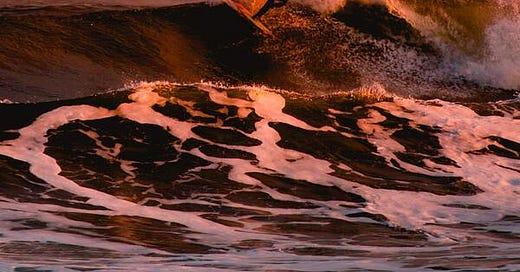This issue features:
River Tiger Podcast - Planning for performance; being adaptive within performance with Craig Morris and Richard Seals.
“You Look at an Ocean; I See the Rips, Hear the Waves, and Feel the Currents”: Dwelling and the Growth of Enskiled Inhabitant Knowledge - by Carl Woods and Keith Davids
Planning for performance
I couldn’t help myself again this month, I had to feature the River Tiger Podcast again! This time with one of my favourite coaches (Craig Morris), talking about planning for and adapting to performance.
I started listening to this podcast while climbing a small mountain in Tasmania, and found myself lost in the scenery until I had to stop to write down this golden thread:
“Evaluating against predetermined ‘movie’ - what you’re supposed to be doing versus acting upon the opportunities as they unfold”.
I loved the analogy of the movie as soon as I heard it, because I knew that is exactly how sooo many people view their performance. When they approach a performance environment, there is an expectation of how it should turn out, and I think that is often reinforced in the way we warm up for events and the way we train, but more on that later.
This movie, for people other than myself, follows a very specific script of how we think our performance should go, and when the real world doesn’t fit our artificial script, we get overwhelmed. It’s almost as if we don’t trust the world in front of us, or at least our ability to navigate it.
And I can see why - we are often highly dependent on second hand information, either intentionally or because it is always present, even if we don’t want or need it.
Photo by Julie Tupas on Unsplash
A great example of this happened to me just recently while driving around Tasmania. We were following a navigation app from St Helens to Hobart, which in theory is a pretty direct route. At one point, the map told us to turn off the main highway (the one highway that literally runs from one end of the island to the other), and into some side streets. While the backstreets were marginally shorter in terms of distance, we then had to re-enter the highway at a highly inconvenient point, and sat there for 10 minutes waiting for a break in traffic.
If we had just lifted our eyes beyond the artificial map, we would have seen the sign further up the road that directed us to Hobart via the highway, as the route was designed. But because we were so unfamiliar with the area and had this very convenient information available, we closed ourselves off from this quite obvious option. Now, I’m not totally game to not set up the map at all while driving through unfamiliar places, but I am definitely more conscious about being open to other sources that I did not anticipate - I am more response-able to the world around me.
In the podcast, Craig also discusses the narrowing of attention and emphasises that we should endeavour to attend to where the invitations for skilled actions will be found, not are found. Then, we should remain open to finding new invitations in the process.
This is such an important distinction to make because I do think we can get caught up in our expectations of the environment and close ourselves off from sources of information that emerge in the moment. I find in cricket, you can ask many batters what kind of information they use to anticipate what ball is coming next, and get a variety of answers (for good reason). While many will struggle to verbalise it, because the process likely is not wholly conscious, others are very quick to highlight that they keep the bowler’s arm in sight as they let go of the ball.
It has been previously shown that this source of information can be helpful in anticipating where that next ball will go, but it’s not as simple as telling someone to look there. Directing someone’s attention for them by instructing them to look at the bowlers arm will not have the same effect.
Why not? They’re doing the same thing right?
Well, the reason we want them to direct their attention there has now been undermined by our instruction - we want them to attune to a key source of information that may regulate their action, but looking is not the same as knowing. This is why a direct instruction to do something is not quite the same as guiding attention towards it. The understanding of why this information source is important and how it can regulate action cannot be imposed upon a learner; it should be explored.
This podcast inspired me in two ways, across two identities: as a wayfinder, and as an experienced other.
As a wayfinder, similarly to as a Stoic, I have realised that it is the ‘movie’ in my mind, the expectation of the world, the imagined suffering that gives my anxiety power. There have been too many times lately where this power has overshadowed my ability to be present, to enjoy the wondrous world for what it is. I can now make a more directed effort to be here, now, and keep myself open to opportunities that cannot be, and should not be, predicted.
As an experienced other, which is how I characterise my coaching, I pay attention tot he way I help others pay attention. I was rarely afforded the opportunity to explore as a young learner, but I have taken it upon myself to do so as an adult. I hope nobody else has to even wait that long, to grow up, before they can feel empowered to explore again.
“You Look at an Ocean; I See the Rips, Hear the Waves, and Feel the Currents”
Every time I become somewhat stable in my understanding of the world, a Tim Ingold quote comes along and destabilised once again. This time, the quote is found at the start of this paper about knowledge.
“Does knowledge actually lead to wisdom? Does it open our eyes and ears to the truth of what is there?… Might we see more, experience more, and understand more, by knowing less?
As I was reading this paper, I was also pondering about the idea of transfer of skills, and ultimately then, transfer of knowledge. I found it was very to conflate knowledge about the environment I was observing as knowledge of, and found it increasingly difficult to differentiate the two in my mind.
I was watching a hockey game for the first time and trying to compare action capabilities with those I could see in front of me. There were some obvious similarities, such as ball control and movement using an implement, structural positioning of the team similar to football, and channels or passages of play that were dynamic and evolving.
But I was able to stop myself from immediately signing up with the notion that I could totally play hockey with just the action capabilities I had accumulated over the years. It slowly dawned on me that I was solely relying on my knowledge about the environment (watching the game, collecting secondhand information from my friend while they played) and conflating it as knowledge of.
It made me realise just how easy that is to do, and why, in sports coaching, we place so much authority and ‘expertise’ on people who have played the game before. We think that somehow, their knowledge experienced of the environment, the way they have come to intimately know the places they inhabit, is transferable through conversation, direct instructions, lectures and/or team meetings. Ironically, we are placing value on their knowledge of but giving them a platform to distill it only as secondhand information, as knowledge about to the receiver.
This is not to say that a coach with inhabitant knowledge in the context they are now coaching in is not relevant or valuable; it is reinforced in the paper that ‘both types of knowledge are important in supporting humans doing the things they do’.
In the realm of sport, we need to be wary of conflating one type of knowledge with the other, not just in the knowledgable person, but also in how that knowledge is developed in others. If “knowledge may not be something to be ‘known about’ but something to be primarily experienced’ as according to Reed, then we need to allow the learners, the knowledge-developers, to benefit from the self-guided discovery and personal growth that comes from experiences.
The role of the coach then becomes less about transmitting our knowledge of the environment to others, because that inherently shifts the knowledge itself. Instead, it is worth reflecting on the learning experiences that shaped us as learners, as athletes, as coaches, so we can provide the same (or better) learning environments for others.
I have certainly learned more about my coaching from the poor, borderline traumatic experiences than I have from the positive experiences, because they have unfortunately stuck with me the longest. They exist in my mind as a ‘don’t do’ list, but hopefully my athletes can never tell.
But there’s something to be said about the memories that bubble up when you’re not expecting it, the unexpected fun that you had one afternoon that has become imprinted with the laughter and joy it brought.
I have one particularly fond memory of an afternoon spent in the mud out the front of my local cricket club, where learning to run between wickets became a slip and slide in the rain, and we got to explore the boundaries of our skill as we tried to turn 90 degrees around markers and slipped over.
Although I prefer to avoid the rain and mud, I hope my athletes have equally bubbly memories of playing in the sun.





